The 3 Most Powerful Downdrafts for 2025: And Why Downdrafts are a Bad Idea for Your Kitchen
October 18th, 2024 | 7 min. read
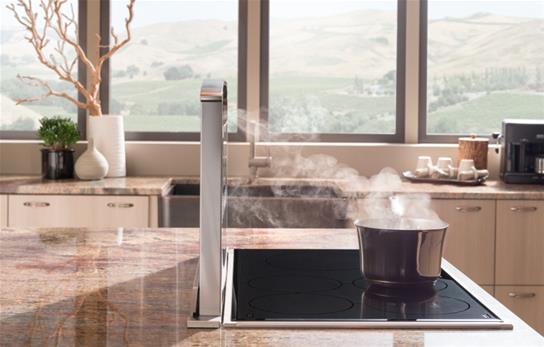
I think I know why you’re here.
You’ve planned a center island with a high-powered range and want a powerful downdraft to vent it.
It’s smart to consider a high CFM exhaust for high-output cooking.
Maybe you saw this setup in a magazine and like the idea of placing your cooking appliances in the middle of your kitchen.
In this article, I’ll show you the highest CFM downdrafts currently on the market. Then, you’ll learn why none of them will work as effectively as you might hope.
As a bonus, I’ll also show you some better options and ideas for your kitchen.
A small note: although I’m not a fan of downdrafts, they’re better than nothing.
Kind of like this inexplicably designed but nicely styled kitchen with no ventilation (see below).

Use this article to find the best solution for your needs—and, hopefully, consider redesigning your kitchen before adding a downdraft.
How to Buy a Downdraft

You can purchase downdrafts ranging from 370 CFM to 1500 CFM.
Downdrafts are a separate item installed behind your cooktop or (heaven forbid) your range.
Typically, when buying a downdraft between 370-600 CFM, the blower and downdraft come as one unit.
For downdrafts over 600 CFM, you’ll need to purchase the blower and the intake (the part that pops up and down) separately.
There are several types of blowers available, depending on what works best for your needs.

Internal Blowers (Most Common)
- Internal blowers are mounted directly to the intake inside your cabinet.
Inline Blowers (Least Common)
- Inline blowers are installed in the duct between the stove and the outside wall.
Remote Blowers (Highest CFM)
- Exterior or remote blowers are installed outside your house.
- Inline and remote blowers tend to be quieter since they’re not located inside the kitchen cabinet.
Keep in mind, if you install an inline or remote blower, you must have access to it later in case repairs are needed. Easy access to the fan is essential.
Pro Tip: Exterior blowers aren’t aesthetically pleasing, so install them in an area that’s less noticeable.
Brands Offering Built-In Vents
JennAir, Fisher & Paykel, and others offer a vent built right into the middle of the cooktop.

Gaggenau offers downdrafts that you place beside your cooktop.
It doesn’t really matter—they’re all ineffective.
Ventilation Basics

First, to understand why downdrafts should be a last-resort option, let me walk you through the basics of ventilation.
Ventilation is divided into four key components:
1. CFM
CFM stands for cubic feet per minute. It's the measure of how much air flows through the vent in one minute.
Downdrafts can vent a significant amount, with a maximum of 1500 CFM—that’s enough to ventilate one small room of air per minute, every minute.
2. Capture
Smoke isn’t expelled the moment it reaches your vent. It needs to be captured before being vented.
This is why you see large hoods in restaurant kitchens.
Capture is best defined by the height, width, and depth of your hood.
Downdrafts, with a 2-inch slit, have virtually no capture area, which makes them ineffective for higher-output cooking.
3. Duct Run
The ideal ducting follows gravity, guiding the smoke where it naturally wants to go—straight up. Short horizontal runs straight back are also acceptable.

However, downdrafts direct smoke downward, against gravity, and then require an elbow joint to transition the airflow, which reduces efficiency.
Most downdrafts also need longer duct runs.
4. Duct Size
Duct size used to be a bigger issue when contractors were using dryer ducts. These days, an 8- to 10-inch round duct is typically adequate for any vent.
Pro Tip: Although some downdrafts can recirculate air, they are even less effective because they don’t remove harmful toxins from the air.
So, now you understand that downdrafts will be challenging, especially if you like to use a wok, grill, or griddle.
They do perform better with induction or electric cooktops.
Why Are Downdrafts Ineffective?
It’s not a new issue, really.
The cooking process emits potentially harmful compounds like carbon dioxide, carbon monoxide, nitrogen dioxide, formaldehyde, and particulate matter.

Think about it.
You’re trying to reverse all of that through a tiny aperture with a long duct run, often with at least one elbow.
That’s a problem.
The issue is further exacerbated because front burners have nearly doubled in power since I started in 1986.
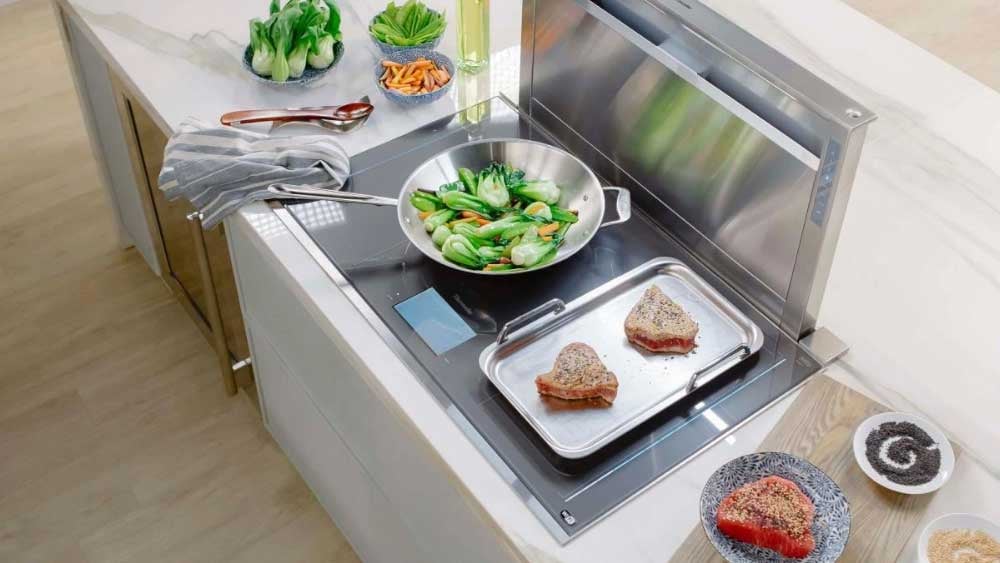
The 8,000 BTU burner my mom used is now 15,000 to 22,000 BTUs on a typical gas range.
Meanwhile, homes today are far more energy-efficient, designed to keep indoor air in and outdoor air out.
As a result, you’re breathing in these compounds for longer.
3 Most Powerful Downdrafts for 2025
BEST D49M30SB ($2,350)
Pair it with an EB15 Exterior Blower (1650 CFM) - $1,585
BEST was the first to design a downdraft for a freestanding range and even a professional range by placing the blower in an adjacent cabinet.
BEST's downdrafts are also available in 36- and 48-inch widths, with either a 600-CFM interior blower, a 1500-CFM inline blower, or a 1650-CFM exterior blower.
Overall, this downdraft has decent features and specifications.
Features:
- 18-inch max height (ostensibly to catch more steam and grease)
- Type 304 steel
- Anti-vibration guards
- Choice of inline, outside, and inside blowers (though it doesn’t make much of a difference)
- Recirculating kit available (sold separately).
Pro Tip: Read the instructions carefully if mounting a downdraft behind a range.
Thermador UCVP36XS ($2,369)
Pair it with the VTR2FZ (1000 CFM) Remote Blower - $869
Thermador is the original downdraft company. It features a 1000-CFM blower and, like the BEST downdraft, it rises to 18 inches.
Thermador claims the UCVP36XS downdraft's 18-inch intake "protects against splatters when cooking and provides better performance in capturing steam and smoke, even from the front burners."
I don’t think so.
Thermador also claims the downdraft’s full-face filters maximize grease capture without affecting airflow.
However, does it really maximize grease capture?
It doesn’t… sorry.
Features:
- Choose from five options of remote, inline, flexible, or integrated blowers— all equally ineffective if you cook a lot
- Silent drive system
- Three power levels offer a range of ventilation options
- LED lighting
- Easy-to-use controls
- Recirculating kit available (sold separately)
Pro Tip: When using a Thermador inline or remote blower, you need to order a blower connecting cable and duct transitions.
Miele DA6891 ($2,950)
Pair it with the DAG600 (600 CFM) internal blower - $249 or DAG1000 (1000 CFM) external blower - $649
It looks nice, but is style really important? Probably not, since downdrafts are hidden when retracted.
The Miele downdraft rises to 16 inches above the cooktop and uses edge ventilation to improve efficiency and air extraction.
The downdraft draws in smoke and odors through a narrow gap around the perimeter of the hood to enhance the capture area and reduce noise.
It's a very stylish downdraft for modern kitchens.
Clever marketing from Miele, but truthfully, you won’t leave a downdraft up after you’re done cooking.
Features:
- 16-inch rise
- 600 or 1000 CFM blowers available (sold separately)
- Dishwasher-safe aluminum mesh filters with stainless steel frame
- 3-speed fan
- Boost level to enhance extraction
- Backlit controls
- The blower shuts off 15 minutes after cooking to remove any residual odors
- Active air clean filter absorbs and neutralizes odors
- Shuts off after 10 continuous hours of use
- Recirculating option (kit required)
Downdraft Alternatives You Should Consider
Range Hoods
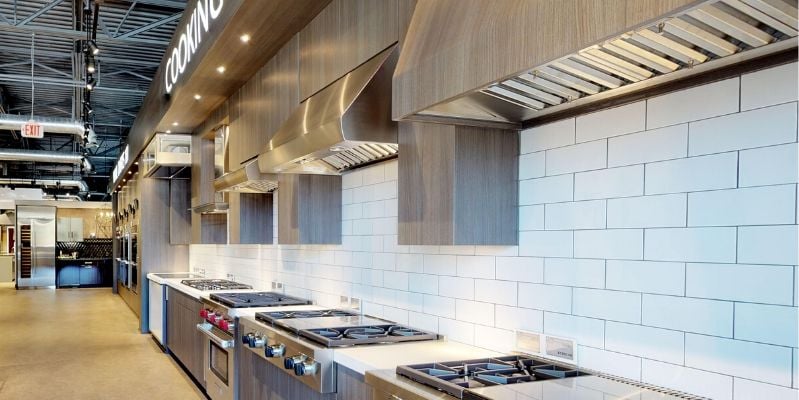
Range hoods have the proper capture area and can be placed over a range or rangetop.
While you don’t want a long duct run, an overhead hood is far superior to a downdraft.
Island hoods were poorly designed when I started in 1986, but the Europeans changed that. BEST, Zephyr, and Faber now manufacture beautiful hoods in a variety of sizes.
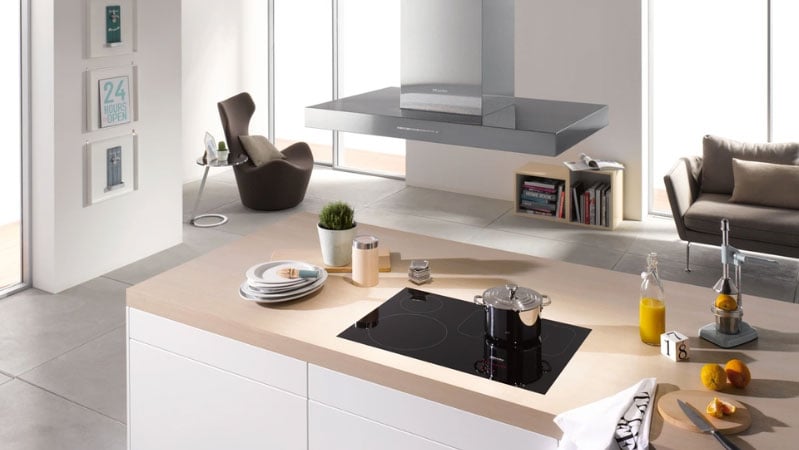
You can even design your own hood. Simply buy a liner, controls, and blowers.
It may sound complicated, but it’s not.
Read More: The Best Ventilation Hoods for Professional and High-Output Ranges
Kitchen Design

You’ve probably seen this setup in a magazine. It looks great—no sightlines are blocked by a hood, and you can entertain guests while cooking on the island.
But think about it.
Downdrafts promote themselves as splash guards for grease, but if you do a lot of high-volume cooking, grease will splatter everywhere.
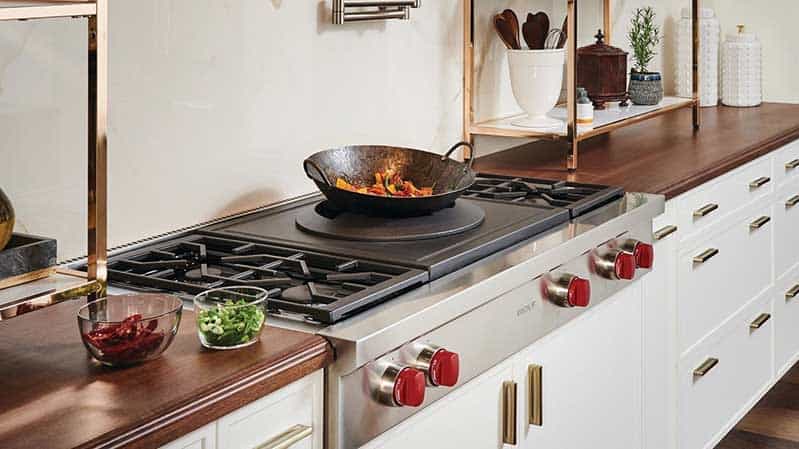
Is that really entertaining?
Maybe, but probably not.
From a kitchen design standpoint, follow a classic rule:
Never be more than one step away from the most-used appliances in your kitchen—namely, the sink, refrigerator, and rangetop.
Start with the Sink

We used to call this my version of the kitchen triangle:

With that in mind, the best appliance to place on your island is your sink, not your cooktop.
You’ll use it the most—seriously.
You could even install an entertainment sink like the Galley Workstation in the center, which comes with every possible accessory to enhance your entertaining experience.
Read More: How to Plan Your Kitchen Appliance Project
Most Powerful Downdrafts: Key Takeaways
Downdrafts may seem like a good idea, but they are often the result of a poorly designed kitchen or a last-resort option, such as a replacement.
Stoves should ideally be placed against a wall with short duct runs to maximize the effectiveness of your vent.
If you must place your cooking area in the middle of the kitchen, consider an overhead vent with good CFM for better capture.
You might also want to consider another design, like placing the sink in the middle.
(I have mine in the middle, by the way.)
The key takeaway is that even high CFM downdrafts won’t effectively vent if you love to cook.
FAQs
Answers to the most commonly asked questions about downdrafts and kitchen ventilation.
What makes a downdraft ventilation system powerful?
A powerful downdraft ventilation system typically features a high CFM (cubic feet per minute) rating, efficient air movement, and advanced filtration technology. The combination of these factors ensures effective removal of smoke, grease, and odors from your kitchen.
Which downdraft models are the most powerful for 2024?
The top powerful downdraft models for 2024 include options from brands like Miele, Thermador, and BEST. These models offer high CFM ratings, advanced features, and efficient performance, making them ideal for serious cooks.
How do I choose the best downdraft for my kitchen?
To choose the best downdraft, consider factors like the CFM rating, compatibility with your cooktop, design, and additional features such as built-in lighting or filters. Also, ensure the downdraft fits your kitchen layout and meets your ventilation needs.
Are powerful downdrafts noisy?
While powerful downdrafts can be noisier due to higher airflow, many modern models are designed with noise reduction features. Look for models with noise-reducing technology or adjustable fan speeds to manage noise levels.
What maintenance is required for high-power downdrafts?
Regular maintenance for high-power downdrafts includes cleaning or replacing filters, checking for obstructions in the ductwork, and ensuring the fan and motor are in good working condition. Follow the manufacturer’s guidelines for specific maintenance tasks and intervals.
Additional Resources
Your kitchen should be a space you love, not one filled with smoke and odors.
Writing the Yale Ventilation Buying Guide was a passion project for me because so many people get it wrong, and it becomes a problem.
Ready to take control of your kitchen air?
Download the guide now to learn how to vent properly and keep your kitchen fresh.
Related Articles:
Why Should You Trust Us?
It seems that every appliance review has nothing but glowing comments about almost every product, yet you read customer reviews and they are almost universally bad.
We are here to fill in the disconnect. We'll give you the best features, and the drawbacks as well, including reliability based on over 37,000 calls performed by our service team just last year. Our goal is to give you ALL the information so you know what's right for you.
Please consider subscribing or adding to the conversation in the comments below. We appreciate you stopping by.
Steve Sheinkopf is the third-generation CEO of Yale Appliance and a lifelong Bostonian. He has over 38 years of experience in the appliance industry, and he is a trusted source of information for consumers on how to buy and repair appliances.
Steve has also been featured in numerous publications, including the
New York Times,
Consumer Reports,
The Boston Globe,
Bloomberg Radio, the
New York Post,
The Wall Street Journal, and
Entrepreneur, for his knowledge of how to buy appliances and appliance repair.
Steve is passionate about helping consumers find the best appliances for their needs, and he is always happy to answer questions and provide advice. He is a valuable resource for consumers who are looking for information on appliance buying, repair, and maintenance.
Despite being the worst goalie in history, Steve is a fan of the Bruins and college hockey, loves to read, and is a Peloton biker. The love of his life is his daughter, Sophie.
A Note About Pricing
Pricing on this blog is for reference only and may include time sensitive rebates. We make every attempt to provide accurate pricing at time of publishing. Please call the stores for most accurate price.





